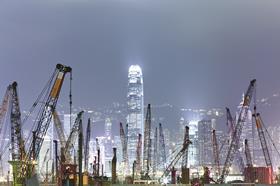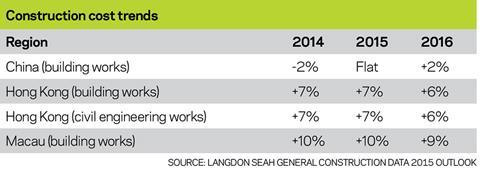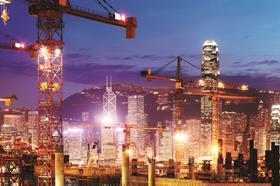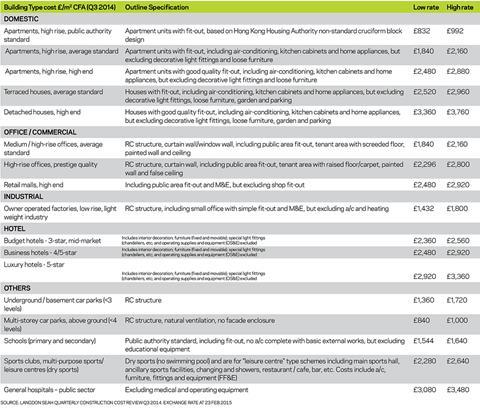How is Hong Kong to maintain its competitive edge with the rise of the emerging Asian cities? Barbra Carlisle of EC Harris, Constance Lau and Tim Robinson of Langdon Seah explore its unique positioning

01 / Introduction
Hong Kong is much more than Hong Kong Island. It is a city that bridges metropolis and tranquility. Its success as a world city is influenced by geography - it has a deep water harbour that acts as a trading gateway to Asia and it is also now part of the economic powerhouse, China. Being a UK colony (1842-1997) boosted its trading, logistics and financial role and as a special administrative region (SAR) of China, the city is benefiting from an influx of Chinese trade, tourists and talent.
Ranked eighth in Arcadis’ Sustainable Cities Index 2015, Hong Kong has excelled at providing its investors and citizens with a good return on investment. GDP per capita was £24,780 (2014), one of the highest in Asia, with land and property prices some of the highest in the world. It was the most expensive place to live and work until 2014 when it was overtaken by London. The city has been able to attract the best Asian and international talent to work in its financial centres, luxury goods markets and on its mega infrastructure and building projects.
As with any global city, wealth inequalities exist, with the gap widening. The government’s annual Policy Address sets out how it is to tackle inequality, including investing in welfare initiatives. Environmental challenges for the city are also covered, including plans to tackle pollution and improve sustainability.
02 / Economic and political overview
Since 1997, Hong Kong has operated as one country; two systems. Domestic affairs are determined by the Hong Kong government while China sets foreign and national defence policy. The city benefits from the Closer Economic Partnership Agreement, which supports economic development by allowing goods to be exported into mainland China tax free. The chief executive of Hong Kong is assisted by an executive council. The legislative council is the law making body and a forum for debating issues of public interest, such as the Policy Address. The Policy Address 2015 sets out how the government will pursue democracy, boost the economy and improve people’s livelihood.
The transition to being an SAR was largely smooth until the issue of universal suffrage was raised by pro- democracy groups in anticipation of the 2017 elections. Opposition is around the pre-screening of potential candidates by China. Recent events in three locations led to blocked roads and prevented travel, affecting Hong Kong business.
As a global city surrounded by granite mountains, where just 25% of land is developed, the city faces challenges in securing land suitable for development. This has led to looking to re-zoning green belt land, repurposing brownfield industrial sites (eg Kowloon) and moving some built assets, like sewage works, out of prime locations and into alternative areas. There is also a waste management challenge to address, because, although 45% of city waste is composted or recycled (compared to London’s 26%), landfill sites are expected to be full by 2018.

03 / Construction sector

Langdon Seah reported total public construction volumes at £5.2bn and private sector construction volumes at £4.1bn (2013). Construction volumes at locations other than sites was £5.4bn. With a 9% year-on-year growth for private sector work and 10% growth in public sector works, the construction industry remains vibrant, though perhaps not as dynamic as may have been expected on the back of the government’s programme for new residential units and large infrastructure projects. Government plans for 480,000 residential units will be realised in the next decade only with the freeing up of land to build on.
There are examples of public programmes experiencing delays due to skilled and unskilled labour shortages. Estimates suggest a potential deficit of 10,000 workers, equivalent to 4% of the workforce.
The construction industry, where wage rises averaged 10% (2014), employs around 250,000 people. Wage rates naturally vary with, for example, carpenters, bar benders and riggers seeing 10% plus rises (due in part to labour shortages and work volumes). Hong Kong’s workforce has skills to work in challenging geotechnical conditions, where major foundation work, slope stabilisation and land reclamation is the norm.
Pegging the Hong Kong dollar to the US dollar has caused it to depreciate by about 10% against the Renminbi since 2010, pushing up the price of imports from China. As a result construction prices have risen. Construction volumes will remain at fairly high levels in the future. In 2014, there was a 7% rise in building work costs and 7% rise in civil engineering works. Price rises are likely to continue. Contractors are cautious about the financial outlook leading to tender prices differences, varying from project to project.
Contractors interested in public projects register on the government’s approved contractor list, banded by value and work type. Contracts tend to be awarded on a lump-sum basis based on competitive tenders, usually against a measured bill of quantities. A main contractor is selected, responsible for the whole project and employing nominated subcontractors.
04 / Infrastructure
The interconnectedness of Hong Kong Island; the New Territories; the international airport; and Kowloon impact on city sustainability, as does the ease of movement of goods and people between Hong Kong and mainland China. The city announced several infrastructure megaprojects in 2007 that are designed to respond to future need and ensure city competitiveness. The projects are all at different stages of design and construction.

Hong Kong international airport (located off Lantau Island) is reaching capacity and its Master Plan 2030 sets out how it is to respond to rising passenger and freight numbers. The only significant landmass left on the largely reclaimed island off Lantau will see the development of the Midfield Concourse. The Midfield Concourse development includes 19 aircraft loading bridges, airfield utilities, airport systems, extension of the existing APM/DCV tunnels, aircraft parking aprons, and extension of the south runway airside road, together with related modification and expansion works in Terminal 1.
Similarly, 16 sewerage master plans aim to respond to the city’s needs whereby 2.8 million cubic metres of sewage are generated from city residents and businesses every day. While new towns in the New Territories have modern systems, it is in the older parts of the city where sewage strategies need to cope with growing pressures. For example, the Harbour Area Treatment Scheme aims to improve water quality for Victoria Harbour by transporting waste through a deep tunnel system from Kowloon and part of Hong Kong Island to a treatment plant at
Stonecutters Island. It will ultimately be discharged into Victoria harbour. Greening initiatives are integral to these plans, including landscape design around treatment plants.
The city is looking at water security projects including commissioning a feasibility study into a water desalination plant in Tseung Kwan O.
Reclaiming land is on the government’s agenda, with Hong Kong Boundary Crossing Facilities Island being one scheme that will see around 130 hectares of land from the open waters north-east of Hong Kong airport being reclaimed by 2016.
05 / Rail, roads & ports
Demand from Chinese tourists - alongside increased volume of trade between China and Hong Kong - is helping the rail industry flourish. As China’s emerging cities expand, rail infrastructure to and from Hong Kong helps competitiveness. The Guangzhou-Shenzhen-Hong Kong Express Rail Link continues to be built, but with two-year delays reported, due to unexpected difficulties in land geology and adverse weather.
Ensuring urban transport meets local demand is also an essential element of remaining competitive and promoting quality of life for residents. Systems that increase capacity, reliability and efficiency of urban rail require the latest technology. While investment is being made, for example upgrading signalling systems on seven metro lines, delays have been reported in urban rail projects, such as the Shatin-Central Link, due in part to labour shortages.
The city’s roads are the most used in the world and incorporate island crossings, mountain tunnels, bridges and flyovers. Built to British standards and style, roads are under pressure from the city’s 700,000 registered vehicles. The 29.6km Hong Kong Macau Guangdong bridge is scheduled to be built by 2016, linking to the yet-to-be-built Hong Kong Link Road and airport.
The deep water harbour has historically influenced Hong Kong’s attractiveness as a trade hub and container volumes continue to increase. However, there are no significant plans to expand cargo terminals at present. The passenger terminal, Kai Tak is now open, opening up cruise ship tourism.
06 / Commercial and leisure

Tall buildings are what Hong Kong does well. It has the most skyscrapers (over 150m tall) in the world, at 302. In the past six years 34 skyscrapers were built, with the International Commerce Centre, completed in 2010, the tallest at 484m. The New World Centre redevelopment in Kowloon, due to complete in 2016, is the largest current project (256m).
The ability to attract retailers, and high-spending shoppers is an integral ingredient for a global city. Retail is big business in Hong Kong, although retail growth has slowed, contracting during 2014 (-0.2%), the first drop since 2003. Retail rents are still the highest in Asia at around £10,000 per m2 per annum for high-end units. The city remains a key retail investment location with many retailers positioning their flagship stores in the city, as part of their Chinese market entry strategy. Prime sites, for example at Canton Road and Harbour City, attract fierce competition between luxury brands and as rental prices grow, new non-core areas begin to feel the benefit, with new malls emerging.
07 / Social and cultural
Almost 5% of GDP is from tourism, where expenditure in 2013 was £27.8bn. A staggering 47.2 million tourists from mainland China visited the city in 2014. For as long as disposable income in China continues to improve, tourism in Hong Kong will flourish. New museums, such as M+, which focuses on 20th and 21st-century art, design, architecture and moving image is due to start on site in 2015 in west Kowloon.
Hospitals, schools and leisure facilities support sustainable communities. There are 11 private hospitals and 42 hospitals under the Hospital Authority. Total health expenditure in 2010/11 was 5.1% of GDP. There have been reports of doctor shortages. Staff shortages and an ageing population place pressure on the city’s healthcare system. The city’s response is to encourage health insurance and the use of private hospitals.
Responding to globalisation and to meet its diverse population needs, Hong Kong is looking to expand international school places in the city. It is also continuing its Business School Partnership programme, which enables students to experience the workplace through mentoring and career experience programmes - all part of building the city’s future talent.
08 / Residential and mixed use
Property prices rose 300% since 2003, leaving many Hong Kongers struggling to find suitable homes. Recent levelling off of house prices, in part influenced by the introduction of stamp duty, is viewed as temporary, with rises predicted.
Housing is seen as a critical issue for the government and its long-term housing strategy aims to address supply and demand. To continue as a sustainable world city, the government needs to release land for private developments and deliver 480,000 homes over the next decade. Between 2014/15 and 2018/19, 77,100 public rental homes are projected to be built. The annual target for public housing is 20,000. Similarly, 74,000 new private homes are projected in the next three-to-four years.
Finding land to build remains a critical challenge, as it does in London. The government view the shortage of land for development as a root of many social and economic problems. The supply of developable land has actually reduced in the city due to environmental protection policies and commitments to lowering density levels. The government is now involved in a large planning consultation process as well as carrying out land use reviews to identify potential land for development.
09 / Outlook
As Hong Kong’s economy further integrates with mainland China, its prosperity will become ever more connected to the mainland’s performance. Free trade agreements, the growth of the middle classes in emerging markets and the globalisation of finance, trade and logistics services all support the expansion of this world city.
As population dynamics shift, it needs to create ways to increase productivity and profitability to support an ageing population and remain competitive globally. Infrastructure projects, education excellence and effective healthcare solutions all form part of
the solution.
Like other global cities, striving to balance people, profit and planet, Hong Kong gives high priority to controlling local air pollution and regional smog problems. This includes the promotion of electric vehicles and reducing energy consumption in government buildings.
Hong Kong has the talent, the investment potential and the location to continue to be a leading world city. Investment and effective execution of its socio-economic policy initiatives to alleviate poverty, engage young people, protect the environment and extend the retirement age all support the sustainable city concept. Harnessing local people power, attracting talent from outside Hong Kong and helping women and the underprivileged to enter the workforce are all clear indicators of intention and need to be accompanied by programme management, appropriate levels of investment and leadership commitment to see the city flourish into the future.
Click on the table above to enlarge.

























No comments yet